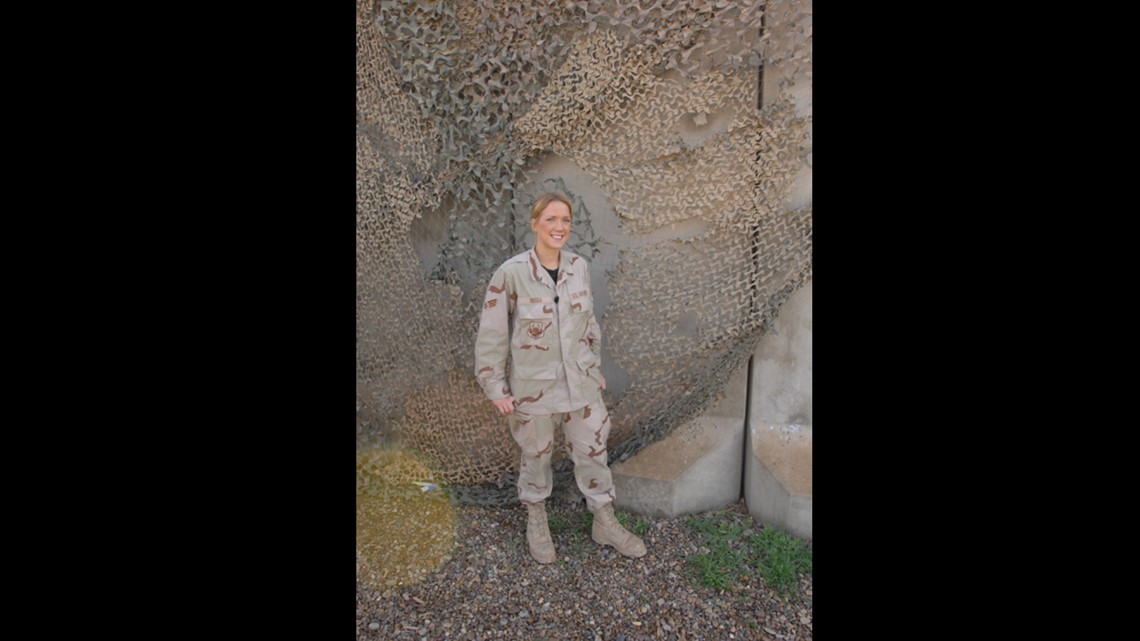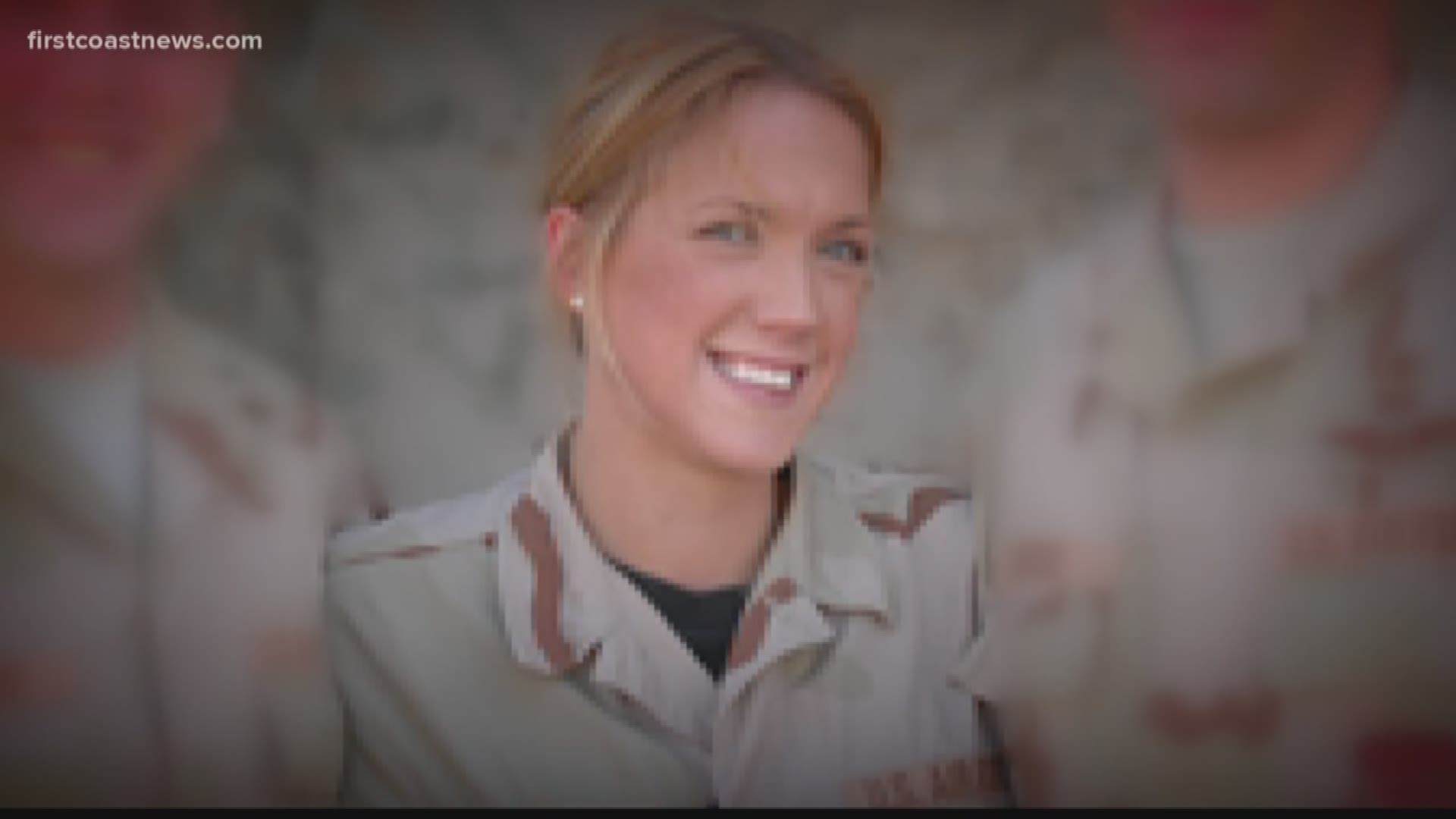JACKSONVILLE, Fla. — Technical Sgt. Nicole Rosga looks like -- and is -- a warrior. What you don’t see are her invisible wounds.


“You know everything that I do I have to gut out now near tears, whereas that’s not who I was,” she said.
Two months after returning from a tour in Balad, Iraq she realized something wasn’t right.
“I noticed just this shortness of breath,” said Rosga. “The doctors were like, 'We can't really find anything, not sure what's up. Sorry.'”
That was 2009. Since then, she says her health problems have only gotten worse.
“One doctor after another, after another, after another," she said. "They’re trying to figure out why I have the shortness of breath, then this G.I. distress and then that leads into a systemic response like my body, everything, just like hurts."
She describes the box of medical records she’s acquired over the past decade as the size of a treasure chest, and still no answers.
“It's just basically that is just complete dysfunction with no underlying cause or an underlying explanation as to what's going on,” said Rosga. “I had to quit a couple of jobs because I just couldn't function. Maybe if I say something someone out there will be like, 'Well, I'm not the only one.'”
Like thousands of other service members and veterans, she believes the source of her suffering began on the ground in Iraq.
Part of her mission with the Minnesota Air National Guard in 2007 and 2009 was to dispose of classified material at Joint Base Balad.
“So one of my jobs was literally being on the edge of the burn pit and burning these pubs, so if you can imagine the black cloud in the air, plus being right there down on the side of the pit,” said Rosga.
What she remembers most about her time deployed to Iraq was the toxic smell coming from the open-air burn pit.
“You know, you'd feel that in your lungs," she recalled. "You would feel the burning afterward, and you would be coughing and cough up, I mean, black stuff, gray stuff, really, really gross stuff, but I didn't have a choice. I was there. I wasn't going to escape it. Nobody was escaping that.”
The potent plumes of smoke hovered over the base day and night.
“At any given time, there were probably about 30,000 people on that base, so you can think about that daily is what they were burning in these open-air pits because there were no incinerators,” said Rosga. “Just open pits of like football fields and football fields of just trash being brought in. They would put jet fuel on this trash to ignite it.”
The Department of Defense says burn pits have been to burn everything from chemicals to paint, plastics, petroleum products, even medical and human waste. They’re still used today in certain situations.
“Burn pits are used during contingency operations only in circumstances in which no alternative disposal method is feasible as determined by the combatant commander," said DOD spokeswoman Heather Babb. "Generally, open-air burn pits are a short-term solution. When used, open-air burn pits must be operated in a manner that prevents or minimizes risks to human health and safety of DOD personnel.”
Retired Lt. Col. Daniel Brewer was an environmental engineer for U.S. Central Command in Iraq and Afghanistan who assessed the bases. He raised concerns about burn pits in 2005.
“The problem is they were throwing anything and everything in the burn pit," Brewer said. "That was my concern. This is a horrible practice. They’re burning all of this really bad stuff at night so you can’t see. That's when people are sleeping so they're breathing all of these fumes all night long and they don't even know it.”
He wasn't the only one to raise red flags. An Air Force memo from December 2006 raised major concerns about the burn pit being an acute and chronic health hazard.
“Nobody believes that anything is wrong with me because I look fine,” said Rosga.
She’s convinced her health issues are related to her exposure to burn pits.
“What else would it be but this thing that I was exposed to that clearly has documentation and page after page after page of these carcinogens and all these other things,” she said.
Rosga has watched others in her unit get sick, some even die after returning from deployment. Amie Muller served with her in Balad. She died of pancreatic cancer at the age of 36, leaving behind her husband and three children.


“So I'm like, well, when is it going to be my turn?" Rosga said. "I always say it's like staring down a barrel."
In 2014 the Veterans Administration (VA) started the Airborne Hazards and Open Burn Pit Registry. It now includes the names of more than 173,000 Veterans and service members, but family members, even those whose spouses died, are not eligible to participate. Senator Marco Rubio says that needs to change.
“I think that's a mistake if you're trying to understand the implications and causation because clearly what you have been exposed to, it manifests differently in different people," Rubio said. "For some, it may have harmed them or killed them early, for others it may take years for the symptoms to show.”
Senator Marco Rubio on Burn Pits:
While the VA is continuing to study the health of deployed veterans, right now it says research does not show evidence of long-term health problems from exposure to burn pits.
“VA encourages all Veterans who feel their military service has affected their health to submit a claim, which will be adjudicated using the latest scientific and medical evidence available," said VA Spokeswoman Susan Carter. "VA has granted service connection for various ailments associated with burn pits, and does so on an individual, case-by-case basis after review of a Veteran’s case."
“If you have unexplained ailments that could be service related, my sense is that the presumption is that it should be service oriented in our thinking in how we treat it,” said Senator Rubio.
“It’s been a decade of delay and denial, and it's time,” said Retired Army Captain Le Roy Torres.
Torres is the co-founder of Burn Pits 360, a veterans organization. He, like Rosga, is suffering after being exposed to burn pits in Iraq and is fighting a debilitating lung condition called obliterative bronchiolitis.
“This is not something I would not expect to come back with," Torres said. "This is why our slogan has been the war that followed us home. I was concerned about getting shot or indirect fire from mortar shots, but never did it cross my mind that I would be suffering from an invisible wound from exposure.”
His group started its own burn pit registry and says more than 500 veterans exposed to toxic smoke from the burn pits in Iraq and Afghanistan have reported they have what they believe to be service related cancers, he knows of more than 100 who have died.
“Veterans are dying and that's why we have to continually put pressure on Congress for there to be change,” said Torres. “We're tired of waiting.”
The VA says of the 11,581 burn pit-related claims it processed between 2007 and 2018, 2318 have been granted. That is 80 percent that have been denied.
“It’s a battle to get these claims approved, and as time goes, the delay and denial, veterans are dying and we don't have the luxury of time like Agent Orange that took decades," said Torres. "We don't have that time.”
He and his organization are pushing for the VA to recognize the link between exposure to burn pits and health problems and pushing for those who are suffering to be compensated.
“Deny, deny, deny,” said Brewer. “I’m part of this link that doesn't exist.”
Brewer has been diagnosed with two nodules on his lung. He doesn't yet know if they're cancerous.
“This is no different than what they did for years with Agent Orange," said Brewer, "wait until enough of them have died off and we can manage it and then we will recognize it. They're going down the same path."
For nine years, Rosga has been on a quest to get a diagnosis.
“I want to feel better, so I can serve better,” said Rosga. "I'm not seeking anything other than just trying to get help and trying to get answers.”
Rosga is now serving with Jacksonville’s 125th Fighter Wing of the Florida Air National Guard and recently deployed overseas. She says it's time for Congress to act and has this message for the VA.
“This is real," she said. "Your people are suffering. When I'm sitting here saying there's something wrong with me, hear me. Let's do something about it because I'm not the only one. I feel like we are owed that.”
Several pieces of legislation related to exposure to burn pits are before Congress including H.R. 663, The Burn Pits Accountability Act. It would require the DOD and the military departments to evaluate whether each member of the Armed Forces has been based or stationed where an open-air burn pit was used to dispose of waste or exposed to toxic airborne chemicals. H.R. 1001 would allow family members of a deceased veteran to add their name to the burn pit registry. H.R. 1005 would require the VA to begin treating veterans suffering from the lung disease obliterative bronchiolitis.
On April 30, 2019, Burn Pits 360 is bringing together a panel of experts for the 2019 Burn Pits Congressional Briefing. They will be discussing how the toxic wounds of war are affecting our veterans, current issues, and how to improve the lives of veterans who served in Iraq and Afghanistan.
The VA is in process of contracting with the National Academies of Sciences, Engineering and Medicine to provide another comprehensive review of respiratory health effects of airborne hazards in Southwest Asia according to spokeswoman Susan Carter. The Academies’ report is expected in mid-2020.
Be sure to watch First Coast News at 11 p.m. Monday to see more on this story.


